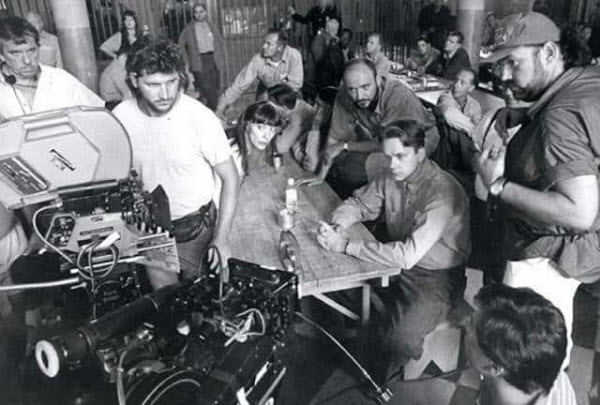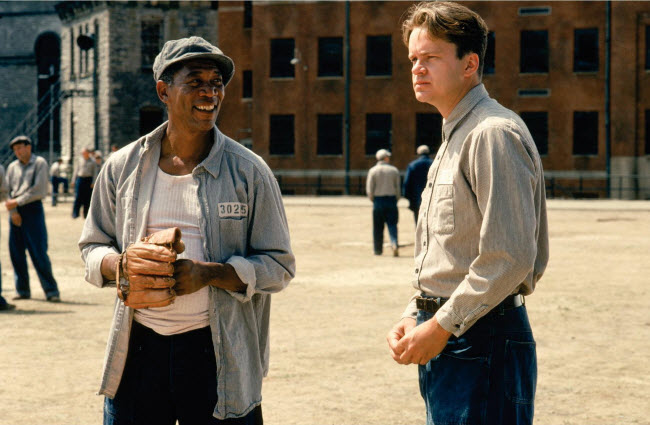The Shawshank Redemption is a profound film that explores themes of hope, freedom, and resilience. Directed by Frank Darabont and released in 1994, this cinematic gem is adapted from a Stephen King novella. The film follows the story of Andy Dufresne, a banker sentenced to life in Shawshank State Penitentiary for a crime he didn’t commit, and his transformative journey through the prison system. Through its powerful performances, gripping narrative, and poignant messages, “The Shawshank Redemption” is widely celebrated as one of the greatest films ever made.
Plot Summary (Warning: Spoilers Ahead)

The Shawshank Redemption centers on Andy Dufresne (Tim Robbins), who is wrongfully convicted of murdering his wife and her lover and is sentenced to life imprisonment at Shawshank State Penitentiary. At Shawshank, he befriends fellow inmate Ellis “Red” Redding (Morgan Freeman), and the two develop a deep bond.
Andy uses his financial skills to help the corrupt prison warden, Samuel Norton (Bob Gunton), manage the prison’s finances and launder money. In exchange, Andy secures a comfortable position for himself and gains the respect of fellow inmates. Over time, he also improves the prison library and helps fellow prisoners achieve their GEDs.
Despite the harsh conditions, Andy maintains hope and focuses on a plan for escape. Over 19 years, he meticulously tunnels through the prison’s walls using a rock hammer, eventually escaping through a sewer pipe into the river outside Shawshank. Andy exposes the corruption of the prison system by sending evidence to a local newspaper, leading to Warden Norton’s downfall.
The film concludes with Andy and Red being reunited in Zihuatanejo, Mexico, symbolizing the triumph of hope and friendship over adversity.
Main Characters and Actors
Andy Dufresne (Tim Robbins): A banker who is wrongfully imprisoned and uses his skills to transform Shawshank Penitentiary from within.
Ellis “Red” Redding (Morgan Freeman): A long-term inmate who becomes Andy’s close friend and narrator of the story.
Warden Samuel Norton (Bob Gunton): The corrupt and authoritarian warden of Shawshank Penitentiary.
Captain Byron Hadley (Clancy Brown): The brutal captain of the prison guards who enforces Norton’s harsh rules.
Brooks Hatlen (James Whitmore): An elderly inmate who is released on parole after spending decades in Shawshank, struggling to adjust to life outside prison.
Tommy Williams (Gil Bellows): A young inmate who becomes Andy’s friend and reveals crucial information that helps in Andy’s escape plan.
Awards and Recognition
The Shawshank Redemption received seven Academy Award nominations, including Best Picture, Best Actor (Morgan Freeman), and Best Screenplay Adaptation. Although it did not win any Oscars, the film has achieved critical acclaim and is consistently ranked among the greatest films ever made. It is celebrated for its outstanding performances, storytelling, and the universal themes it explores.
Trivia (100 Interesting Facts)

- Based on Stephen King: The film is adapted from Stephen King’s novella “Rita Hayworth and Shawshank Redemption.”
- Tim Robbins’ Preparation: Robbins studied real-life prisoners to prepare for his role as Andy Dufresne.
- Morgan Freeman’s Narration: Freeman’s role as narrator was crucial to the film’s reflective tone.
- Initial Reception: The film was not a box office success upon its initial release but gained acclaim through home video and television.
- Iconic Line: The line “Get busy living or get busy dying” is a memorable quote from the film.
- Rock Hammer: The rock hammer, used by Andy to tunnel out of Shawshank, is a key symbol in the film.
- Filming Location: The film was shot primarily in the Ohio State Reformatory in Mansfield, Ohio.
- James Whitmore’s Performance: James Whitmore’s portrayal of Brooks was praised for its depth and realism.
- Prison Library: The prison library scenes were filmed in the real Shawshank Penitentiary library.
- Costume Detail: Tim Robbins wore a fake nose to better resemble a character with a more prominent nose.
- Editing: The film’s editing, particularly the use of cross-cutting between different storylines, was highly praised.
- Clancy Brown’s Role: Clancy Brown, who played Captain Hadley, is also known for his voice acting in various animated series.
- Brooks’ Parole: Brooks’ release and subsequent struggles reflect the challenges faced by real-life elderly prisoners.
- Cameo: Stephen King makes a cameo appearance as a prisoner in the film.
- Music Score: Thomas Newman’s score for the film enhances its emotional depth and atmosphere.
- Box Office: The film grossed over $28 million domestically, which was modest compared to its acclaim.
- Critical Acclaim: Over time, the film received numerous awards from critics’ associations and was included in several top film lists.
- Cinematography: The film’s cinematography, by Roger Deakins, is renowned for its atmospheric and effective portrayal of the prison environment.
- Red’s Narration: Morgan Freeman’s narration is considered one of the film’s strongest elements.
- Rita Hayworth: The title references the iconic actress Rita Hayworth, who symbolizes hope for Andy and his fellow prisoners.
- Redemption Theme: The theme of redemption is central to the film, both for Andy and other characters.
- James Whitmore’s Oscar: Despite his strong performance, James Whitmore did not receive an Oscar nomination.
- Famous Scene: The scene where Andy plays opera music over the prison loudspeakers is one of the film’s most iconic moments.
- Acting Awards: Morgan Freeman’s performance is widely regarded as one of the best of his career.
- Production Design: The film’s production design accurately represents the 1940s and 1950s prison setting.
- Sewer Pipe Escape: Andy’s escape through the sewer pipe is a crucial plot point and symbolizes his long-awaited freedom.
- Book Sales: Sales of Stephen King’s novella increased significantly after the film’s success.
- Film’s Impact: The film’s message of hope has resonated with audiences around the world.
- Critical Reception: Initially, the film received mixed reviews but was re-evaluated as a classic over time.
- Cultural Impact: The film has been referenced in various cultural works and media.
- Casting Choices: The casting of Tim Robbins and Morgan Freeman is considered one of the film’s greatest strengths.
- Famous Quotes: The film features several memorable quotes that have become part of popular culture.
- Book Adaptation: The film’s adaptation is noted for its faithful representation of the source material.
- Set Design: The set design accurately reflects the bleak and oppressive environment of Shawshank Penitentiary.
- Release Date: The film was released on September 23, 1994.
- Long Runtime: The film’s runtime is 142 minutes, allowing for a detailed exploration of its themes.
- Box Office Performance: Despite its initial box office struggles, the film became a major success in subsequent years.
- Soundtrack: The film’s soundtrack plays a significant role in setting its tone and mood.
- Film’s Message: The film’s message about the power of hope and friendship is its most enduring quality.
- Narrative Structure: The film’s narrative structure, including flashbacks and voiceovers, enhances its storytelling.
- Set Location: The Ohio State Reformatory served as a key location for creating the film’s authentic prison environment.
- Red’s Name: The character Red is named for his red hair in the original novella.
- Box Office Ranking: The film ranked 72nd on the American Film Institute’s list of the 100 greatest American films.
- Film’s Length: The film’s length allowed for an in-depth exploration of the characters and their stories.
- Critical Analysis: Critics have praised the film for its strong performances, direction, and screenplay.
- Cinematic Influence: The film has influenced numerous other films and television shows with its themes and style.
- Film’s Legacy: Over time, the film has become a beloved classic with a significant impact on audiences.
- Film Festival: The film premiered at the 1994 Toronto International Film Festival.
- Visual Style: The film’s visual style contributes to its overall tone and emotional impact.
- Character Development: The development of Andy and Red’s characters is a key strength of the film.
- Symbolism: The film uses various symbols, such as the rock hammer, to represent hope and perseverance.
- Narrative Depth: The film’s narrative depth adds to its emotional and thematic richness.
- Film’s Popularity: The film gained popularity through word-of-mouth and home video sales.
- Filmmaking Techniques: The film’s use of long takes and close-ups adds to its cinematic effectiveness.
- Acting Chemistry: The chemistry between Tim Robbins and Morgan Freeman is widely praised.
- Audience Reception: The film has a strong following and is often cited as a favorite among moviegoers.
- Emotional Scenes: The film features several emotionally powerful scenes that resonate with viewers.
- Cultural References: The film has been referenced in various works of literature, film, and television.
- Production Challenges: The film faced several production challenges but succeeded in delivering a powerful story.
- Directorial Vision: Frank Darabont’s directorial vision is evident throughout the film’s narrative and style.
- Book Influence: The film’s adaptation has influenced other adaptations of Stephen King’s works.
- Redemption Theme: The theme of redemption is explored through the characters’ personal journeys.
- Film’s Message: The film’s message about the importance of hope and friendship is universally relatable.
- Real Prison Experience: The film’s depiction of prison life is grounded in real-life experiences and research.
- Audience Impact: The film has left a lasting impact on audiences with its powerful story and characters.
- Memorable Scenes: The film features several memorable and iconic scenes that are widely recognized.
- Awards Consideration: Despite its critical acclaim, the film did not win major awards but remains highly regarded.
- Cinematic Techniques: The film employs various cinematic techniques to enhance its storytelling and emotional impact.
- Actor Performances: The performances by Tim Robbins and Morgan Freeman are central to the film’s success.
- Film’s Atmosphere: The film’s atmosphere is created through its setting, cinematography, and soundtrack.
- Legacy: The film’s legacy continues to grow, with new generations discovering its brilliance.
- Critical Praise: The film has been praised by critics for its strong narrative and emotional depth.
- Audience Favorites: The film is often listed among audience favorites and top film lists.
- Cinematic Achievement: The film is considered a cinematic achievement for its storytelling and character development.
- Visual Imagery: The film’s visual imagery enhances its themes and emotional impact.
- Cultural Impact: The film’s cultural impact can be seen in its references and influence on other media.
- Screenplay Adaptation: The screenplay adaptation effectively captures the essence of Stephen King’s novella.
- Character Arcs: The film’s character arcs are well-developed, adding depth to the story.
- Film’s Tone: The film’s tone is both somber and hopeful, reflecting its themes of redemption.
- Historical Context: The film’s setting and characters are reflective of the time period in which it is set.
- Acting Ensemble: The acting ensemble contributes to the film’s overall effectiveness and impact.
- Emotional Depth: The film’s emotional depth is heightened by its strong performances and storytelling.
- Directorial Style: Frank Darabont’s directorial style is evident in the film’s narrative and visual presentation.
- Audience Connection: The film’s connection with audiences is a key factor in its lasting popularity.
- Film’s Impact: The film has had a significant impact on viewers and has become a beloved classic.
- Narrative Complexity: The film’s narrative complexity adds to its overall richness and appeal.
- Cinematic Techniques: The use of cinematic techniques enhances the film’s storytelling and emotional impact.
- Character Relationships: The relationships between characters are central to the film’s narrative.
- Cultural References: The film has been referenced and parodied in various forms of media.
- Film’s Success: The film’s success is attributed to its strong performances, direction, and screenplay.
- Emotional Resonance: The film’s emotional resonance is a key aspect of its enduring appeal.
- Film’s Structure: The film’s structure effectively supports its themes and narrative.
- Legacy and Influence: The film’s legacy and influence continue to be felt in the world of cinema.
- Critical Reassessment: The film has been reassessed as a classic and continues to receive acclaim.
- Memorable Moments: The film features several memorable moments that have become iconic in cinema.
- Film’s Message: The film’s message about hope and redemption is a central theme throughout.
- Viewer Experience: The viewer experience is enhanced by the film’s powerful storytelling and performances.
- Cinematic Techniques: The film’s use of cinematic techniques contributes to its overall impact.
- Cultural Impact: The film’s cultural impact is evident in its references and influence on other media.
- Enduring Classic: “The Shawshank Redemption” remains an enduring classic, appreciated for its depth, storytelling, and emotional power.
